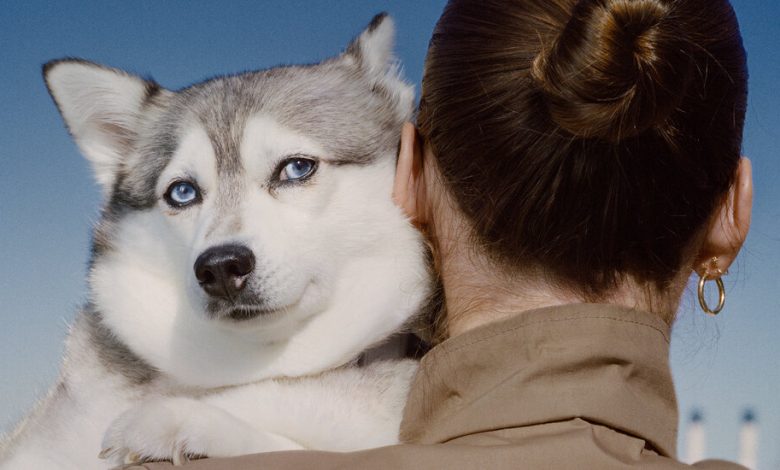My Year of Being Very Online About Dogs

Supported by
SKIP ADVERTISEMENT
Alicia P.Q. Wittmeyer
My Year of Being Very Online About Dogs
-
Share full article
-
9
By Alicia P.Q. Wittmeyer
Photographs by Mark Peckmezian
Ms. Wittmeyer is an editor in Opinion.
If you own a dog and have ever searched the internet for advice on that dog, there’s a good chance you’ve encountered Zak George.
Mr. George, a 45-year-old with 3.69 million YouTube followers, and the slightly goofy, hyper energy of a doodle mix, is the most popular dog trainer on the platform. He’s the most popular by a long shot: Cesar Millan, the dog whisperer,has 2.71 million. Those trying to deride Mr. George — and there are many — will often say he stopped being a dog trainer a long time ago; what he is now is a dog influencer.
I’ve watched Zak George’s videos for years; I deployed them as background noise while doing dishes, or folding laundry. I watched as he worked with untrained rescue dogs to prepare them for new homes. I watched as he road-tripped across the country in a camper van with his two dogs and his wife. Every once in a while, there were hints that he had bigger things on his mind: his videos in which he said the dog training industry needed to confront its “misogyny,” for instance.But mostly his content consisted of him training his dogs: Inertia, a black and white Border collie, and Veronica, a rescue mutt with a cute underbite.
Then, around this time last year, I watched, transfixed, as Mr. George began launching broadsides against an approach to training dogs known as “balanced training” (more on just what that is in a moment). In video after video, he declared that the dog training industry had reached a crisis point and that it was time for a reckoning with those in the profession who train with what are called aversives — tools that cause a dog discomfort.
The videos did what they were intended to do: They sparked a response. But not just any response. Comment sections filled with discussions on “woke idiot[s]” in dog training. “Radicals are Hijacking Dog Training” posted one trainer, calling force-free training, the anti-aversive movement of which Mr. George is arguably the most prominent face, an “ideology” and a “cult” with a “radicalized agenda” — language that sounded awfully familiar.
Even before this, I’d seen the occasional Instagram post by a trainer using terminology that seemed drawn from another context: I’d paused on several posts that applied the term “consent” to dogs — as in, we should get their consent before we pet them. In some cases, the trainer’s vocabulary seemed drawn from even more distant shores: “I will not project colonial, capitalist, or patriarchal concepts on my dog,” one post read, in between tips on leash reactivity and separation anxiety; “don’t gaslight your dog,” another urged.
But Mr. George’s series of videos seemed to send whatever process had generated those posts into overdrive.“It sounds like dog training has become just one more target for the woke community to prey upon!” a YouTube user wrote. “These are the same people with ‘gender fluid’ dogs,” another wrote, a statement that I found funny, then spent too long trying to parse. (What is standard gender expression in dogs?) I watched a video in which a trainer referred to the “dog training far left,” which should have made no sense, except that at this point, I knew what he meant.
For the most part, I watched this confusing web of associations go unquestioned; when I found commenters who shared my bewilderment, I screenshotted them with relief. “People are trying to conflate their anti-liberal politics with dog training,” a YouTube user named Bar posted. “Its super weird.”
Of course, it would be silly to say that dogs can’t be political: Anyone who has seen photos of German shepherds at civil rights marches should appreciate that they can.
But there seemed to be something different about what was happening here. The creep of this sort of language into a subject this far afield felt like the apotheosis of something. When I’d describe what I’d seen to friends, it often sparked a visceral combination of exhaustion and despair. (“I kind of hate knowing about this,” one said; “we deserve climate change,” another said.) These were the late-stage culture wars — in decline, perhaps, but still with enough life left to flare up and set fire to new and unexpected territory. Including dogs.
On the surface, the dispute Mr. George threw himself into centered on a long-running debate: Should you make a dog physically uncomfortable as a means of changing its behavior?
Force-free training — or positive reinforcement training, as it’s often called — in the simplest terms rejects the use of physical punishments, known as corrections. Dogs are trained not through punishing the bad behavior but by rewarding the good: A dog sitting politely on his bed while his owners eat dinner should be showered with treats, for instance.
Few trainers today would take issue with the idea of positively reinforcing a behavior you like. Where things get more contentious is what to do about behavior you don’t like.
Proponents of positive reinforcement training say you stop bad behavior through a combination of management measures (drawing the curtains, for a dog that won’t stop barking at passers-by) and reinforcing alternative behaviors you prefer (giving treats to reward moments of not barking). A balanced trainer, by contrast, might suggest a bark collar — a device that emits a negative stimulus, like a shock, or a high-pitched sound, whenever the dog gets set off.
Those who argue for the end of punishment say, at best, it’s unnecessary and unethical, and at worst, can have unintended consequences: A punished dog might become more fearful, and therefore more likely to bite. Those who argue that corrections have their place say that positive training too often prioritizes the dog’s comfort over the owner’s and that in extreme cases, tools like e-collars and prong collars are the only way to handle dogs who would otherwise be put down for aggression. Positive trainers have the backing of organizations like the American Veterinary Society of Animal Behavior; balanced trainers dismiss such organizations as at odds with their real-world experience.
All this is emotive territory and can certainly make for a tense argument. But it still didn’t seem like enough to account for how, in a world already awash with political shorthand, dog training methods had seemingly become yet another signifier.
Was it just coincidence that so many balanced trainers seemed to be men in tight shirts who trained Belgian Malinois in protection sports? Why did positive trainers seem to post so often about mental health (canine and human) — and why did so many balanced trainers complain about dogs being overmedicated? Why did so many positive trainers talk about following the science, and so many balanced trainers talk about science having an agenda? Each of these questions, taken on their own, had an explanation. Taken together, they managed to map out the battle lines of the culture wars with unsettling precision.
Occasionally, I’d wonder if I was making too much of what I’d seen. After all, a majority of owners were almost certainly blissfully unaware of these dynamics. Had I become too online about dogs, of all things, animals notorious for insisting you touch grass twice a day?
Then I would stumble on something that stunned me anew with its insistence that dog training methods were a cultural front line — “balanced trainers who try to paint themselves as ‘the nice guys’ will also be the target of the Woke mob” — and I would feel a renewed sense that what I was seeing was very real, and was simultaneously both absurd and terrible.
There is a way of seeing what has unfolded in dog training as a function of the internet and social platforms. Dog training has taken readily to video-based platforms like YouTube, Instagram and TikTok, which lend themselves to demonstrating physical skills. It also requires no certification process, an approach that aligns with the ethos of the internet, where anyone can claim to be anything, and scrollers are left on their own to determine credibility.
In the past few years, these factors combined with the pandemic, which sent a wave of new dog owners onto the internet looking for help, to draw yet more trainers online. Today the world of online dog training can be overwhelming: Who actually knows what they’re talking about? How is an owner to gauge whose advice to take?
What I was seeing was, in part, dog training just adopting internet-y language. These platforms are where we consume everything now: politics, culture, entertainment, said Robert Topinka, who studies digital culture at Birkbeck, University of London. They each have their own grammar, syntax, vocabulary and aesthetics. Shorthand bleeds easily from one subject to another. Thus, the idea that you don’t need to exercise authority through fear while training becomes “Don’t Be a Cop to Your Dog.”
Faced with more information than anyone can possibly sort through, Dr. Topinka said, users tend to judge creators by affect and vibes. In 2023, one ready way to signal a vibe is either wokeness or anti-wokeness. And so: Who should I turn to to figure out how to train my dog to walk on a leash? The guy who insists he’s not going to be politically correct about it.
But this explanation may imply a level of calculation that’s not quite right. Everyone I spoke to for this story was deeply sincere (these are, after all, dog people): “The world of dogs does not exist in a vacuum of pet guardian and pet, but is interconnected with systemic oppression,” Rachel Forday, a positive trainer, told me when I asked about her use of political language. “Systemic oppression dictates who is allowed to own a dog and what kind of dog they own.” Robert Cabral, a balanced trainer, worried in one of his videos that the rise of science citations in dog training was turning the profession into an “elitist realm.” “I have an issue with that,” he said. “I’m a simple guy, I didn’t go to college …. I think when you make things complicated you cut out a lot of good people.” The vibes these people are projecting are simply who they are.
But “vibes generate their own momentum,” Dr. Topinka said. They feed off the vibes of other creators; they encourage stridency and positioning within an ecosystem.
Despite having begun a high-profile anti-balanced-training campaign, Zak George didn’t, at first, seem particularly inclined to draw a connection between training methods and politics. Over time, though, I’d noticed this shifting: In an Instagram Live video in late summer, for example, he and his wife covered subjects ranging from pronouns and trans rights to racism in policing to toxic masculinity, and how all of these subjects, in some way, relate back to dogs.
Was this a case of vibes generating their own momentum?
I finally spoke to Mr. George in September. During our conversation, he agreed that he was talking about these subjects more; he seemed to see it as simply a growing willingness on his part to draw valid connections between dog training and cultural issues. Our conversation reminded me that in some articulations, there is nothing so outlandish about the idea that a person’s worldview might shape the way he trains dogs. The reasonspeople train with aversive tools is multifaceted, he told me, and not all of it has to do with their politics. But some of it does: The still-pervasive idea that in training, humans have to establishdominance, for instance — it’s not such a stretch to connect that to societal ideas about masculinity.
But our conversation was also a reminder that flattening everything we discuss on the internet into the same debate — one that follows the same scripts and uses the same shorthand — is actually not great if the goal is a productive discussion.
Applying the term “consent” to the question of petting dogs stood out to mein this regard: We might flinch at the word being used in this context, but most people, balanced trainers included, would agree that it’s important to recognize when a dog doesn’t want to be touched. A contentious term was masking an area of agreement.
When I brought up consent with Mr. George, though, he jumped to defend it: “People have a visceral reaction: How dare we say that dogs need to consent?” he told me. “And actually, that underscores a lot of the toxic masculinity that we have.” When I stopped him to clarify that the objections I’d heard were not about toxic masculinity but about the implied equivalence between sexual assault and unwanted dog petting, he paused; he seemed to have genuinely never thought of it that way before. Could using a less loaded term possibly be a better approach for discussing the actual topic at hand?, I suggested. He conceded it probably would.
At the time we were speaking, Mr. George’s war against balanced training had taken a dramatic twist: He was now leading what could only be described as a full-fledged cancellation campaign against another dog trainer — a particularly egregious one, whose tactics some balanced trainers disparaged too.
This certainly felt like an escalation. Mr. George was calling for his followers to show up and protest this trainer’s events, to contact venues who host him and leave them bad reviews; he was tagging institutions and other prominent dog trainers, urging them to issue statements . Between mid-August, when he’d started the campaign, and mid-September, when we spoke, he had posted on Instagram dozens of times; a vast majority of those posts had been about this trainer.
Was this an instance of vibes generating their own momentum? Mr. George’s commitment to force-free dog training is deeply held and, again, undeniably sincere. He told me he wasn’t doing this for engagement or clicks, and this also seemed true: His most popular videos on YouTube, by far, have nothing to do with the dog training wars — they’re tips on how to train a puppy. And that other trainer: He really is egregious.
At the same time, the campaign seemed perfectly calibrated to validate the perspectives of those who’d previously sounded hysterical and overwrought. In other words, it looked like a woke dog-training mob, after all.
There’s another way of thinking about what’s happened here that’s not so much about the internet.
In a 2017 paper, a Norwegian researcher, Ane Moller Gabrielsen, detailed a strange phenomenon: Dog training in Norway had also divided into two camps, which essentially mirrored those in the United States — positive training (via a device called a clicker) and “traditional” training. Those camps, too, had mapped onto a social divide, but it was a slightly different one — not “woke” and “anti-woke,” but women and men.
It was not necessarily the case that more women trained one way and more men trained another, Dr. Gabrielsen found — actually, there were more female trainers than male trainers across all forms of training. But the training methods had themselves become gendered: Advertisements for Canis, the country’s main positive training institution, “often featured women succeeding at clicker training while several men watched with disbelief,” Dr. Gabrielsen wrote. By contrast, Hundefaggruppen — the traditionalist training school — “often presented clicker trainers as naïve young girls.”
Dr. Gabrielsen’s work seemed to describe a phenomenon similar to the one I observed in a very different social context. When we spoke, she said she’d thought about my questions: Was this about social media? 2023? She wanted to offer another idea: This was about dogs.
Crucially, both methods of training — positive training and balanced training — work, she said. With time and consistency, effort and skill, both will, in most cases, give you a dog that behaves the way you want it to. Dogs — so highly attuned to humans — have lived with us for a long time; they’re good at understanding what we want from them. But as a result, they become vehicles for our self-expression in a way that most other animals do not.
Dogs are where we project our “fantasies about what we want: either who we want to be or what we want the world to look like,” said Katharine Mershon, a professor of religion and philosophy at Western Carolina University who studies the role of dogs in American society.
Dr. Mershon told me how dogs had become a focal point for tensions in her rural Appalachian town: Her local NextDoor was filled with arguments about whether leaving hunting dogs to roam about freely, slightly underfed and living mostly outside, constituted abuse. This was an argument, ostensibly about dogs, that was actually about gentrification and the place of newcomers to impose their values on local life.
At points in my conversations with both Dr. Gabrielsen and Dr. Mershon, we discussed the poet, philosopher and animal trainer Vicki Hearne. “Dogs are domesticated to, and into, us,” Ms. Hearne wrote in her 1986 book “Adam’s Task.” “And we are domesticated to, and into, them.”
No neutral observer in dog training’s internecine fights, Ms. Hearne was brutal to the point of being genuinely shocking in her training methods. She railed in her writing against the sanctimoniousness of those who she felt refused to respect dogs enough to let them earn the consequences of their choices.
But among the various points she stressed in “Adam’s Task” — her effort to bridge the gap between academia and animal training — was humanity’s capacity for telling itself stories about dogs and horses, the creatures we’ve bred to accompany us through the human world. We see what we want to in them; they respond to our vision. “Quarrels about training technique are almost never about whatever the surface issue appears to be,” she wrote.
“It’s so easy to project ideas of discipline and loyalty and obedience and all this strong leadership — it’s so easy to project that upon dog training,” Dr. Gabrielsen told me. “But at the same, it’s just as easy to project ideals of democracy, equality, reward-based, no-punishment — because it all works.”
From this perspective, it’s not that the structures of the internet ensure that the culture wars will come for every subject; it’s that the culture wars were always inevitably going to come for dogs.
A confession — and it’s something you might have guessed already: I first found myself going down this particular rabbit hole because of a problem with my own dog.
About two and a half years ago, on a sunny summer morning, Finn, our spaniel-greyhound-saluki mix, chased after a jogger. He’d never done it before, and even as I cringed and went to go collect him, I hoped that this might be a one-off thing.
It wasn’t. I still live in fear that the photo the jogger rage-took of us after Finn bounded after him will surface on social media, even though I apologized profusely. During this period, I spent hours online looking for answers on how to deal with my problem animal.
Zak George was my first stop on this journey. But once I’d followed him on Instagram, the algorithm kicked in, offering me content from other positive training accounts too. Was I dogfluenced? I’m not sure, but eventually, I opted for a solution to my dog’s jogger-chasing that is very common in positive reinforcement training (though is used by some balanced trainers too): I started using a ridiculously long leash. It is 32 feet long, long enough that we can play a real game of fetch while he’s wearing it, but I can still grab it and reel him in quickly if he misbehaves. It’s so long that it often attracts comments and questions.
Another confession: At some point, I started thinking about getting an e-collar for my dog. He seemed, in some ways, an ideal candidate: neither aggressive nor fearful, just a dog who might get to run around a little more freely if I could make it very clear that chasing joggers was not, in fact, a fun game.
I never did it. I don’t exactly know why; I can’t untangle my bundle of motivations well enough to fully understand them. Was I worried about being a cop to my dog? Was I just not the kind of person who uses e-collars? (In signifier terms, I’m not.) Did I simply just not want to buzz him if he did something bad? I definitely didn’t — but I can’t confidently say that was the only impulse at work.
We’re living through a funny juncture when it comes to the culture wars and the internet. The structures of the internet are evolving at the same time that the grounds on which the culture wars are being fought are shifting. Even over the past few months, I’ve felt a subtle tenor change across this particular slice of the web. It’s not that the temperature of the dog training wars has gone down; if anything, it may be going up — Zak George has begun talking about pursuing legislation against aversive tools. But the trainers do seem to be, in ahard-to-pin-down way, more focused on dogs: Fewer threads about training techniques are devolving into fights about vaccines; I’ve seen very few major dog accounts venture an opinion about Israel and Gaza. Whether, in a few years’ time, we’ll emerge in a place where it still behooves people who train dogs to give off a politically tinged vibe and whether owners like me will still internalize those vibes — we’ll see. What does seem guaranteed — and is, frankly, kind of a bummer — is that regardless of what happens with this particular iteration of the culture war, dogs will always be destined to become goofy, oblivious vehicles for human conflict.
On the other hand: What do they care, really? Finn and I still take walks with the giant leash; I still get comments on it and fight the urge to feel self-conscious. Finn, for his part, doesn’t really seem to mind and probably doesn’t know what he’s missing.

Alicia Wittmeyer is an editor in Opinion.
Mark Peckmezian has been photographing dogs as a passion project since 2010. For this essay, he photographed dogs over two months in the fall at over a dozen New York City parks and dog runs, and while out on daily walks.
The Times is committed to publishing a diversity of letters to the editor. We’d like to hear what you think about this or any of our articles. Here are some tips. And here’s our email: [email protected].
Follow The New York Times Opinion section on Facebook, Twitter (@NYTopinion) and Instagram.





